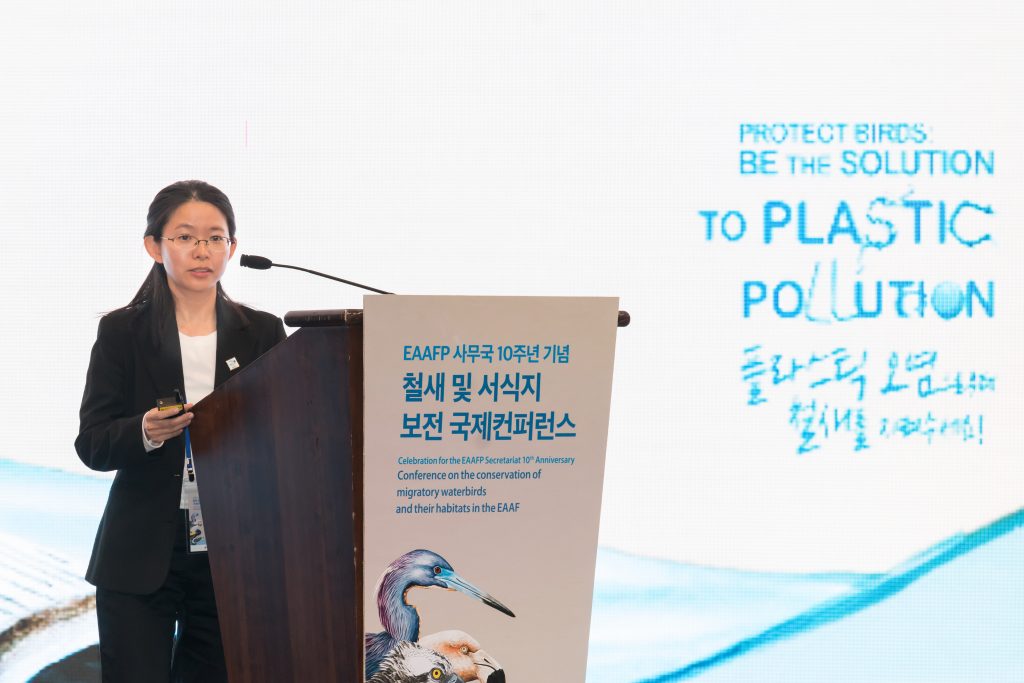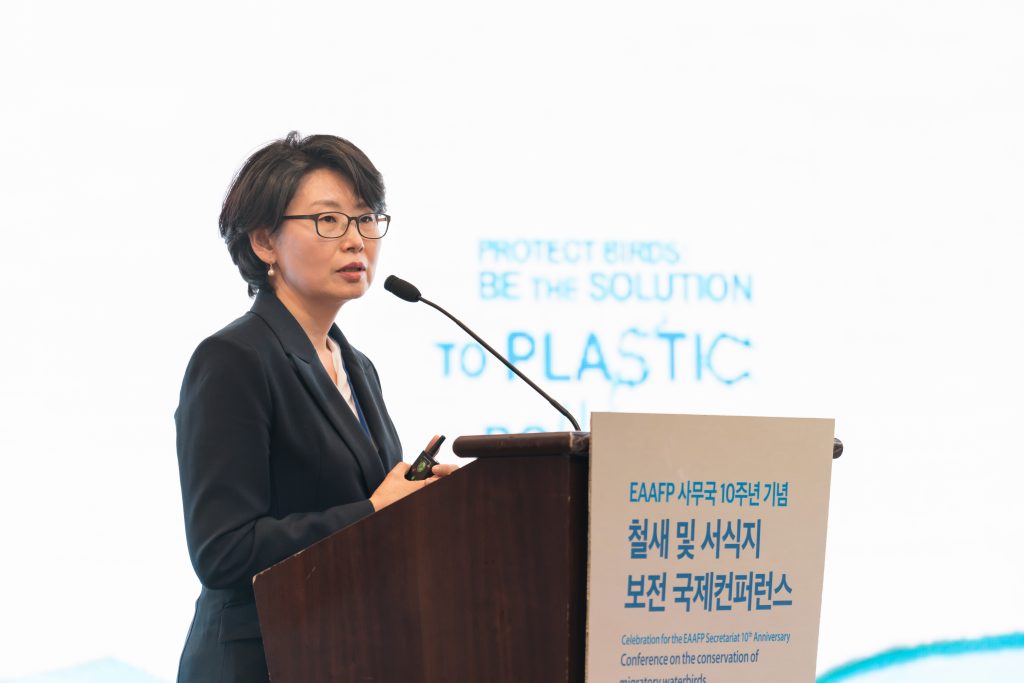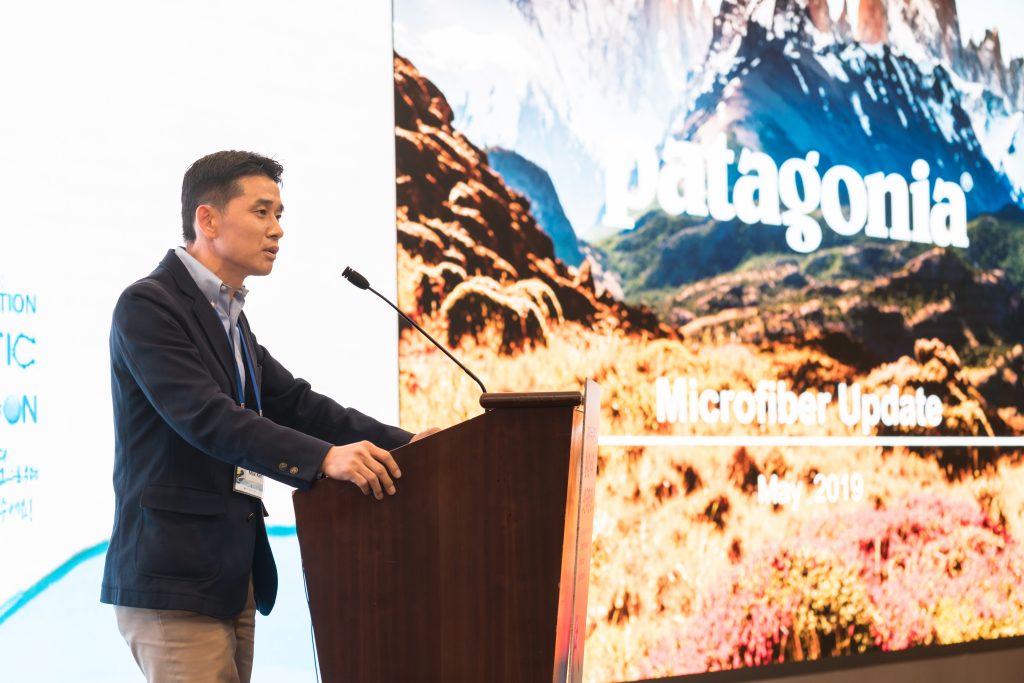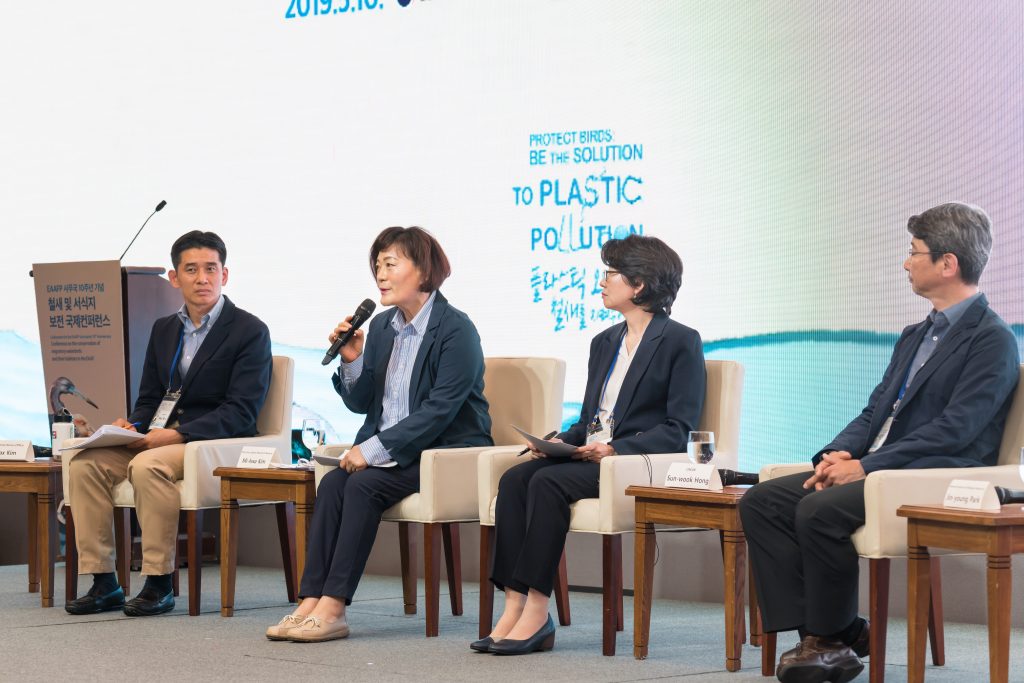In celebration of the global campaign – World Migratory Bird Day, we dedicated the last session to the theme of World Migratory Bird Day for this year, “Be the solution to plastic pollution”. For these special sessions, the speakers focused on the situation that our migratory waterbirds face with plastic pollution and solutions. This session started with the first screening of the World Migratory Bird Day video produced by EAAFP Secretariat.
Overview of global pollution impact and World Migratory Bird Day in the EAAF
During this special session, Ms. Vivian Fu from the East Asian Australasian Flyway Partnership Secretariat gave an overview of the global situation of plastic pollution and how it is affecting wildlife and migratory waterbirds. During the presentation, Ms. Fu illustrated how serious plastic pollution is and how these debris leaks and pollutes the ocean, and the alarming rate of increase in plastic production worldwide. Every year 8-13 million tons of plastic is deposited in our oceans. With this amount of plastic being deposited into the ocean it is no wonder that 500-800 marine and coastal species are affected by marine debris, in which half of that marine debris is plastic.
Ms. Fu continued to explain how wildlife, especially waterbirds are impacted by plastic debris is by ingestion and entanglement. With the immediate need for action, Ms. Fu mentioned a number of global campaigns that are aiming to reduce the amount of plastic pollution in our world, which can be done by everyone. In her closing statement, Ms. Fu recognized World Migratory Bird Day and calling for actions to tackle this problem.
 Presentation by Ms. Vivian Fu from the East Asian Australasian Flyway Partnership Secretariat (Photo© EAAFP Secretariat)
Presentation by Ms. Vivian Fu from the East Asian Australasian Flyway Partnership Secretariat (Photo© EAAFP Secretariat)
Impact of plastic pollution in the Republic of Korea
Next Speaker, was Dr. Sunwook Hong, Head of the OSEAN. She delivered a speech on ocean plastic pollution, particularly in East Asian ocean area. Since 2010, OSEAN, based in Tongyeong, Republic of Korea, has been researching to understand the situation of ocean plastic litter in this region and its impact to the ecosystem and try to promote the solution to this problem. They have been collecting the data from the field and research on the impact of plastic pollution.
According to her research, the entanglement and the ingestion are the most dangerous factors to the wildlife. Among the materials, fishing gears (including abandoned and broken ones) are main items injuring and even killing wildlife. Just within the research zone, they discovered that 21 species have been suffered from plastic pollution, and 93% of them were the birds. Through these studies at only a small part in Ro Korea, it is not hard to imagine how serious the situation is on a global scale.
OSEAN also work on awareness raising, including distributing some educational materials to fishermen to reduce the waste from recreational fishing gears. Additionally, they collaborated with fishing TV programme channel to show the impact of the ocean plastic from fishing gears. Lastly, she called for participation in the International Coast Clean-Up activities happened in everywhere around the world and asked for help to collect the data onsite.
 Presentation by Dr. Seon Wook Hong from OSEAN (Photo© EAAFP Secretariat)
Presentation by Dr. Seon Wook Hong from OSEAN (Photo© EAAFP Secretariat)
How do we address plastic pollution in the Republic of Korea?
Our final speaker for the special session was Mr. Max Kim, from Patagonia Korea. As the only speaker from a private company, Mr. Kim focused his presentation on the immediate threat of microfiber pollution. Mr. Kim started off explaining that microfibers are released into the water systems via washing clothes in a washing machine. Since these fibers are too small to be filtered by washing machines, around 5% of all the microfiber plastics in the Oceans originate from textiles. With the current trend of increasing usage of plastic, it is predicted that by the year 2050, 99% of seabirds in the world will have plastics in their bodies, and there will be more plastics in our oceans than fish. As the threat of plastics in our oceans is ever growing, Mr. Kim has challenged us to help reduce the pollutants in our daily lives. One way we can do is by capturing our microfibers that come from our clothes. Mr. Kim introduced “Coral Ball” produced by Patagonia, that you put into your washer, as your clothes are being washed the Coral Ball absorbs the harmful microfibers and prevents them from entering into the water system. As Mr. Kim reached his closing statement, he applauded Patagonia for donating 1% of their sales to environmental organizations and environmental organizations thought Korea.
 Presentation by Mr. Max Kim from Patagonia Korea Office (Photo© EAAFP Secretariat)
Presentation by Mr. Max Kim from Patagonia Korea Office (Photo© EAAFP Secretariat)
After the presentation, Dr. Dong Uk Han, as the Chair of this special session, initiated the discussion on ‘How could we solve the pollution to conserve migratory waterbirds and their habitats in RO Korea’ by inviting speakers from this special session on the stage. New speakers including Dr. JinYoung Park from National Institute of Biological Resources and Ms. Miwha Kim from Korea Zero Waste Movement Network.
First of all, to recognize the overall amount of plastic pollution and the impact on the sea, Dr. JinYoung Park mentioned that the research on plastic pollution in ROK is still at the beginning stage. However, as the concern on plastic pollution has been increasing a lot, the research on plastic pollution to nature will go on. According to the research in the East Sea of ROK covered by NIBR, even though their research had proceeded in the limited area and time, the impact on wildlife was very critical.
Regarding on the items of plastic debris, Ms. Miwha Kim from Korea Zero Waste Movement Network, said ROK is not manufacturing the microfibre by themselves, but there are a lot of imported plastic product and chemicals and there isn’t any specific regulation or policy on these commercial activities. As Mr. Max Kim from Patagonia Korea Office has presented, the microfibre from synthetic apparel is one of the biggest sources of pollution in ROK.
To mitigate the amount of plastic, as Korea Zero Waste Movement primarily works on pushing the government to legislate concerning on the management of waste, Ms. Kim argued it is necessary to monitor the corporates’ activities and make a regulation or a tax system to reduce consumption of such huge amount of plastic. Additionally, based on the OSEAN research data, Dr. Hong elaborated that the biggest source of pollution on marine waste is the fishing gear which causes the entanglement to marine wildlife. To alert this matter to the fisherman, OSEAN has been educating the fisherman and arguing that a responsible fishing license is desirable to save the marine environment. It is necessary to legislate to regulate the activities of the individual and corporates.
 Panel Discussion “‘How could we solve the pollution to conserve migratory waterbirds and their habitats in RO Korea” (Photo© EAAFP Secretariat)
Panel Discussion “‘How could we solve the pollution to conserve migratory waterbirds and their habitats in RO Korea” (Photo© EAAFP Secretariat)
Lastly, every participant agreed that it is essential to tackle this matter through coordination as it’s not involved in just one sector of the environment. For instance, Dr. Park showed an example that there is a new strategy of managing marine waste published by the joint research of ROK government departments. Actions should not be only carried out at the government level. In order to share the updated data investigated, a continuous discussion platform on this plastic pollution matter is also essential.
**Launched in 2006, World Migratory Bird Day (WMBD) is an annually celebrated awareness-raising campaign aiming to inspire the worldwide conservation of both migratory birds and their environments. The global campaign is organized by two international wildlife treaties administered by the United Nations Environment Programme (UNEP) – the Convention on the Conservation of Migratory Species of Wild Animals (CMS), and the African-Eurasian Migratory Waterbird Agreement (AEWA). On the second Saturday of May and Oct every year, people around the world take action and organize public events such as bird festival, education programmes and birdwatching excursions to celebrate WMBD. For more information, https://www.eaaflyway.net/project/what-is-wmbd/
[EAAFP] World Migratory Bird Day 2019 (Eng)





